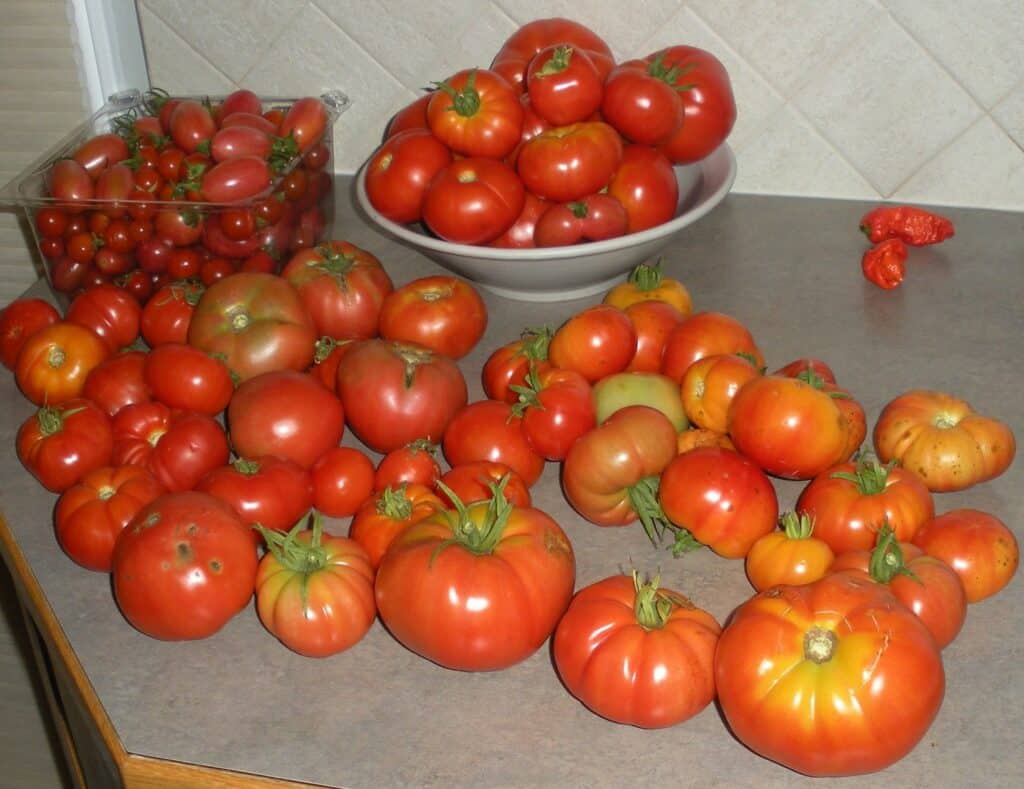
Article and photos by Rob Danforth
If you have found a tomato or a selection of cultivars that you like to eat and that have been successful in your garden, consider saving seed so you can enjoy them all again next season. Seed saving is easy but decisions have to be made before you pick and eat them all!
Save seed from healthy plants only; avoid all diseased plants. Ideally, it is best to save a mixture of seed from 3 different plants; however, you can also be successful if you save only one great tomato from one plant – I have done both successfully, although only one tomato is a gamble that all the seeds are viable and have not been pollinated with a different tomato variety.
Choose one tomato plant and the one tomato you wish to save, or choose 3 of the healthiest tomato plants and select 3 tomatoes, one per plant, and leave these to ripen until they appear a little past eating ripeness. If they have fallen to the ground before you get to them, they are still useable – sloppy, a little ugly, but useable. Collect these tomatoes.
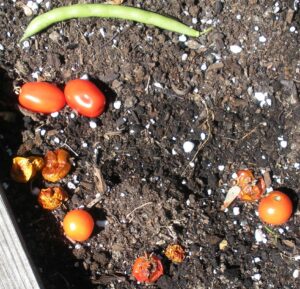
Note: Seed production takes a lot of energy from plants and productivity slows. Restraining your plants will avoid this energy drain. Seeds are powerhouses with all they need to start growing! We let them fully charge before we collect!
Cut the tomatoes and scrape the seeds with the jelly-like mass into a fermenting dish and cover with water for up to 3 days. Fermenting will remove the jelly coat that covers the seeds and give you clean seed. Good seed will sink to the bottom and dead seed with debris will float. Pour off the smelly liquid, dead seed, and debris from fermentation, rinse the good seed, and then dry the seed on a firm surface (not paper!). Spread the seeds out – no clumps — for up to 2 weeks.
If you do not wish to ferment the seeds, you can also allow the seeds, bits of skin, pulp, and jelly to dry spread out on a hard surface for 2 weeks. Scrape the seeds and debris off the hard surface (I use a metal drying sheet or baking sheet and a putty knife) to loosen the material and then separate seeds from each other and from the debris. Separating out the seeds is a challenge, but a manageable one (a pair of knives helps – one holds while the other pulls seeds away). Seeds plus some clinging debris can be planted quite successfully – it is what happens in nature.
Write the name of the seed and the year on the seed envelop (we purchased some, but usually we make our own with recycled envelopes cut to size and scotch taped), place seed in the envelop, and store seeds cool, dry, and dark, in temperatures that do not vary drastically. Refrigerating is not necessary.
Next April (e.g., 1st week), plant the seeds indoors to get a start on the season. Tomatoes can take over 100 days to mature. Cherry and grape tomatoes may take about 60 days and they do not ripen all at once so you can pick often. Beefsteak will take a longer time and many will ripen at once if you have restrained the plant.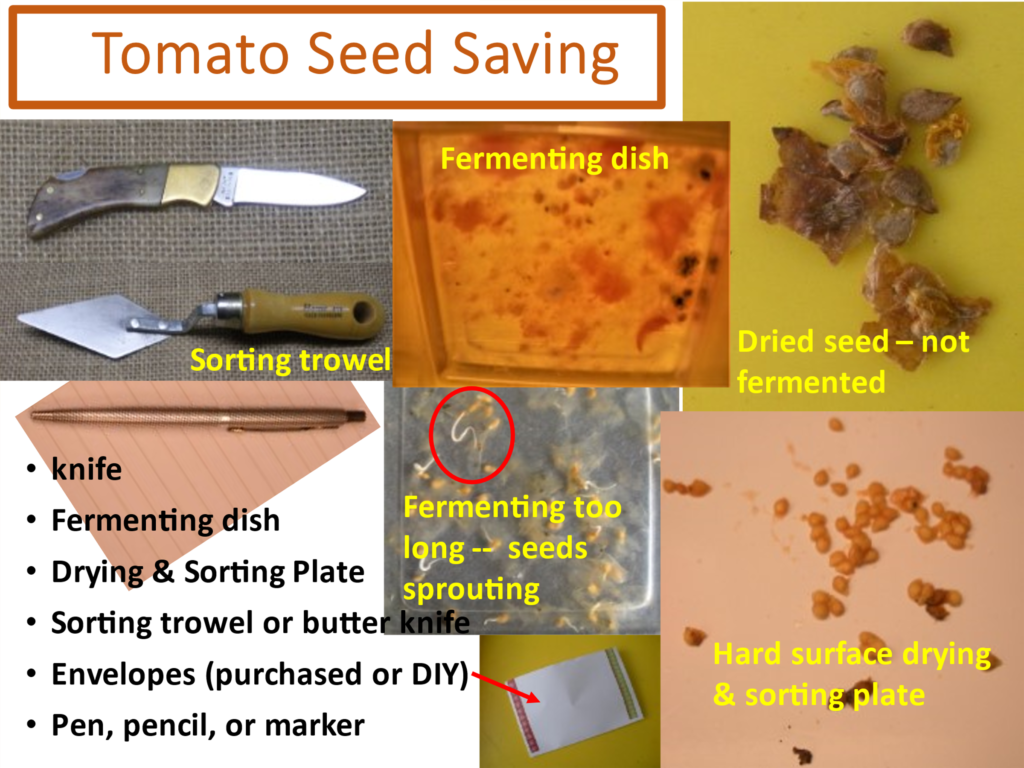
Tomato Salvage!
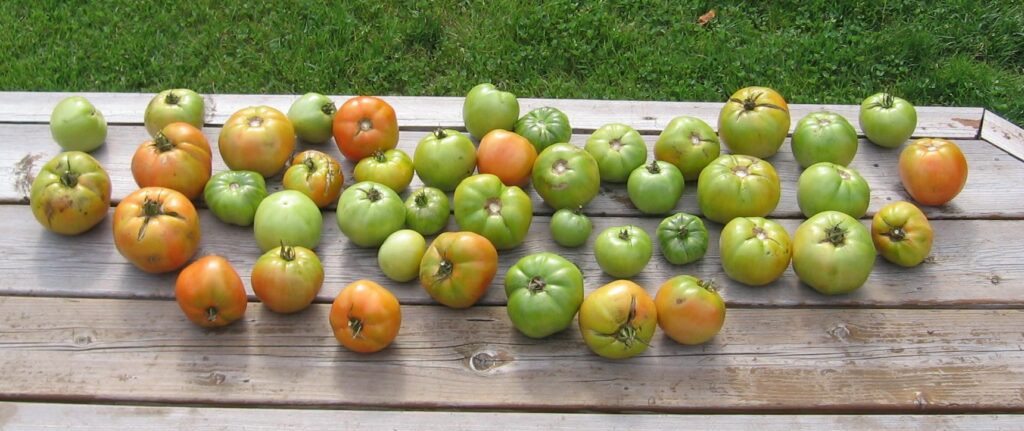
The season has ended and you are left with tomatoes still green on the vine! Pick the medium to large ones and ripen tomatoes indoors in brown paper — no sun and no refrigeration — just in a container in a closet, or even just in a basket on the kitchen counter. Avoid sunlight which will toughen the skins and sun is not needed for ripening.
You may lose some of the tomatoes to decay, but most will ripen. Check often to eliminate bad tomatoes as they will affect the others. Having fresh fruit nearby (e.g., bananas or apples) can hasten the process as the fruit will give off ethylene gas which speeds up ripening.
Alternatively, you could try fried green tomatoes or a green tomato relish/salsa.
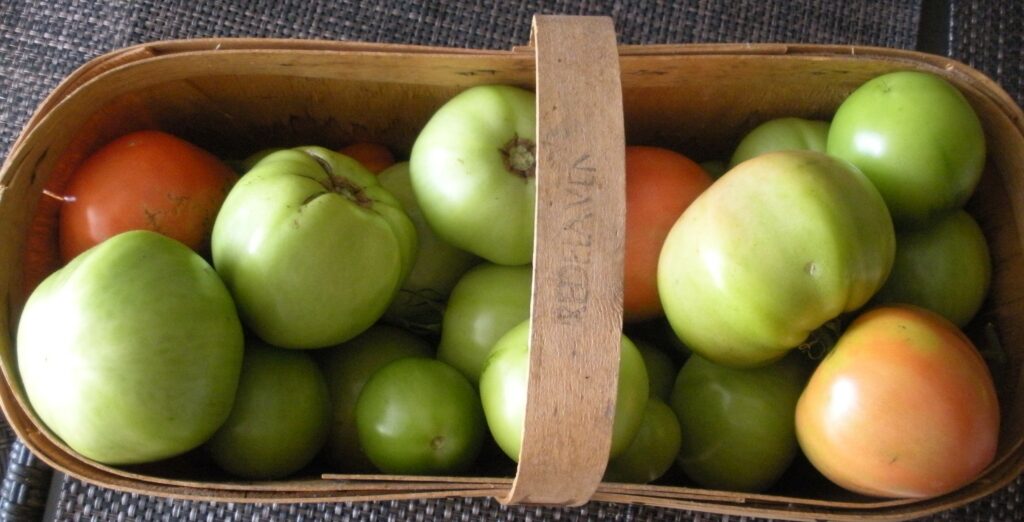
GENERAL STORAGE NOTES:
When your tomatoes are ripe, store them on the counter, not the fridge. The fridge will change the flavour. Of course, you will have to eat them or use them in a relish or sauce before they soften.
When your hot peppers are ripe, put them in the freezer in a zip or silicone bag, and take one out to scissor (still frozen) into bits to add to a Pho, stir fry, or sandwich. Replace what you do not use in the freezer immediately.
Grocery store bananas are picked green and arrive green; they are exposed to ethylene gas to ripen them; however, fresh fruit also emits its own ethylene gas. This can be a concern in a basket of mixed fresh fruit sitting on a kitchen counter.
You have perhaps heard of the problem of one rotten apple in a barrel of apples? The rotten one hastens the demise of all the others. Check often and take the necessary steps.
This is also true for lettuce. Rotting leaves will hasten the decomposition of the other leaves near them, both on your plants or in your fridge. Remove the decaying leaves ASAP or they will turn into a smelly liquid and quickly reduce your lettuce supply.
Finally, potatoes and onions stored where they can smell each other will cause the potatoes to chit and the onions to send up a green shoot.
Happy Gardening!
DTE Tomato series: Starting & Transplanting, Maintenance, Disease & Stress Management, Tomato Salvage & Seed Saving.